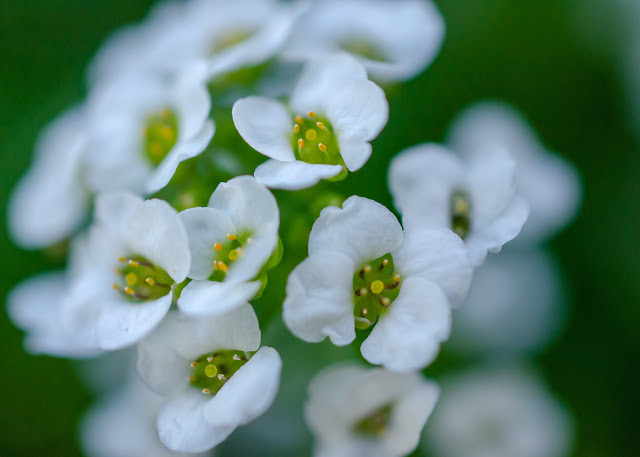 |
| Hydroids |
This was taken after the kelp was moved to the tank. Otherwise, the hydroids lie flat. These are tiny, hair-thick, colonial animals, like the bryozoans; each little "flower" is a feeding polyp waving its tentacles in the water. Some of the hydroids carried semi-circular dorid egg masses.
 |
| Polka-dot fan |
I don't know if this is an alga, a hydroid, or some other critter. The strands are separate, each one a stem with a row of dark spots. This was a photo on a plate; once inside the tank, they disappeared.
 |
| Kelp snail and tank resident, a periwinkle |
There were a half-dozen of these little snails on the kelp. Moved to the tank, they feel free to move about; about half the time they're on kelp. Their tentacles are white; the periwinkles' are black.
I don't know what animal, probably a snail, maybe the snails above, laid these eggs. They've been transferred to the aquarium. Maybe some will hatch.
Besides these, there are always copepods dashing about, exploring the eggs and the hydroids, skimming over the bryozoans. I saw a pregnant female, hauling her green packet of eggs. Here one split second, lost to sight the next. They're fast!
~~~~~~~~~~~~~
Cada rama de alga "kelp" sostiene una comunidad. Aparte de los briozoos y los nudibranquios, encontré estas criaturas en la rama que cortamos el sábado pasado.
1. Hidroides. Son animales pequeñísimos, coloniales como los bryozoos. Cada "florecita" es una boca rodeada de tentáculos buscando su comida en el agua. Esta foto fue tomada después de que puse el alga en el acuario; fuera del agua, se aplastan y cierran sus "boquitas" (pólipos).
2. No sé si este es un alga o un animal. Son pequeñas fibras, cada una con su hilera de puntos negros. En la foto, está separado en un plato. Puesto en el tanque, desapareció.
3. Había una media docena de estos caracolitos (los cafecitos; el otro es un viejo residente del acuario, un bígaro común) en el kelp. En el tanque están igualmente contentos en el kelp o trepándose en las conchas y algas ya establecidas.
4. Anillo de huevos amarillos. Probablemente pertenecen a un caracol marino, posiblemente los de la foto superior. Hay varios ahora en el tanque. Tal vez algunos eclosionarán.
Aparte de estos, siempre hay copépodos dando vueltas, siempre con gran prisa, vistos por un instante mientras pasan de un escondite a otro. Vi una hembra con su paquete verde de huevos. Por un segundo nada más, y luego se había largado. ¡Tan rápidos que son!
















































